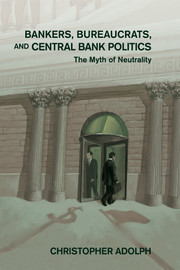Book contents
- Frontmatter
- Contents
- List of figures
- List of tables
- List of boxes
- Abbreviations
- Acknowledgements
- 1 Agents, institutions, and the political economy of performance
- 2 Career theories of monetary policy
- 3 Central banker careers and inflation in industrial democracies
- 4 Careers and the monetary policy process: Three mechanism tests
- 5 Careers and inflation in developing countries
- 6 How central bankers use their independence
- 7 Partisan governments, labor unions, and monetary policy
- 8 The politics of central banker appointment
- 9 The politics of central banker tenure
- 10 Conclusion: The dilemma of discretion
- References and Author index
- Subject index
- About the type, figures, and data
- Other Books in the Series
7 - Partisan governments, labor unions, and monetary policy
Published online by Cambridge University Press: 05 April 2013
- Frontmatter
- Contents
- List of figures
- List of tables
- List of boxes
- Abbreviations
- Acknowledgements
- 1 Agents, institutions, and the political economy of performance
- 2 Career theories of monetary policy
- 3 Central banker careers and inflation in industrial democracies
- 4 Careers and the monetary policy process: Three mechanism tests
- 5 Careers and inflation in developing countries
- 6 How central bankers use their independence
- 7 Partisan governments, labor unions, and monetary policy
- 8 The politics of central banker appointment
- 9 The politics of central banker tenure
- 10 Conclusion: The dilemma of discretion
- References and Author index
- Subject index
- About the type, figures, and data
- Other Books in the Series
Summary
All short sentences in economics are wrong.
ALFRED MARSHALLPOLITICAL ECONOMISTS' EXPLANATIONS of 1908s economic performance often focused on labor market arrangements or elections and partisan governments. Starting in the 1990s, political economists turned to central bank institutions. Literatures based around each of these explanations developed in isolation, grew in popularity, then faded, for the most part, into the background. More recently, comparative political economists revisited these ideas in the context of richer, interactive models of economic performance. These new models focused on the interplay of labor markets and central banks. Yet there has been little effort to update earlier interactive models of parties and unions, and no tests for three-way interactions among parties, unions, and monetary authorities. This chapter fills these gaps to better understand how political actors and institutions affect the real economy. As in Chapter 6, I test these interactive models using direct measures of central bank conservatism, so that our results do not rest on weak proxies or dubious assumptions.
The focus of this chapter is the unemployment rate, which results from the interaction of wage bargaining centralization and monetary accommodation. Introducing partisan governments to the framework, I develop a model of unemployment in which partisan governments and unions reach bargains exchanging wage restraint for social policy, with both sides anticipating the central bank may respond to excessive wage demands with restrictive monetary policy. According to the theory developed here, union–government bargains will be most effective to the extent that (1) labor markets are moderately centralized, (2) central banks are inflation hawks, and (3) governments are willing to spend significant sums to reduce unemployment.
- Type
- Chapter
- Information
- Bankers, Bureaucrats, and Central Bank PoliticsThe Myth of Neutrality, pp. 205 - 239Publisher: Cambridge University PressPrint publication year: 2013



